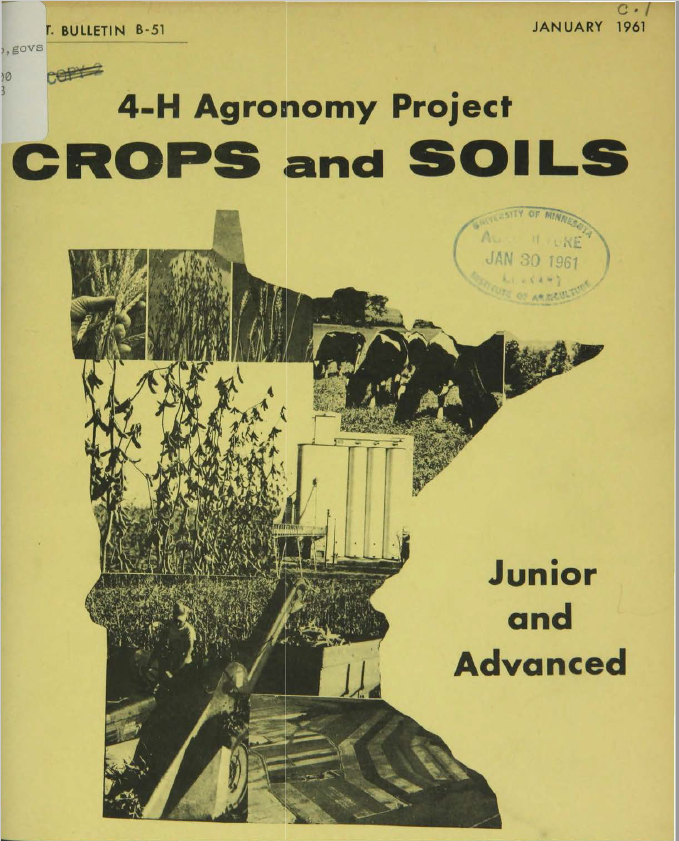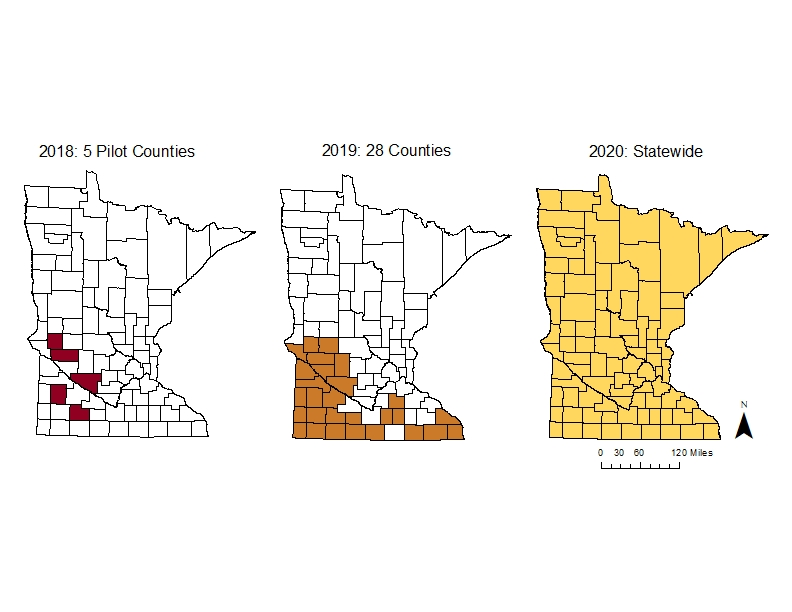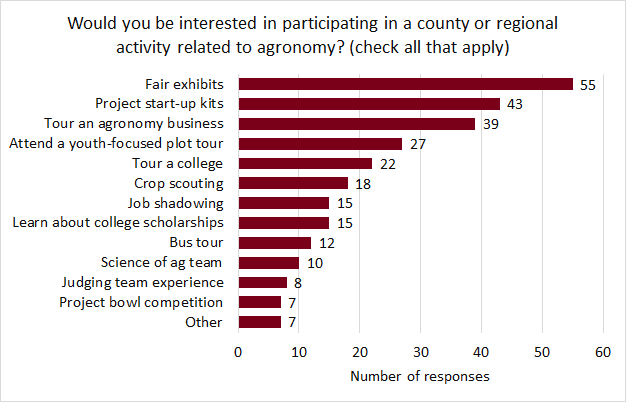Journal of the NACAA
ISSN 2158-9429
Volume 13, Issue 1 - June, 2020
Engaging Minnesota Youth in Agronomy
- Goplen, J. J., Extension Educator, Crops, University Of Minnesota Extension
McNeill, B., Extension Educator, 4-H Youth Development, University of Minnesota Extension
ABSTRACT
Minnesota has over 100 years of history offering 4-H agronomy projects to youth. However, it has been decades since the 4-H agronomy program has seen dramatic changes or updates. Beginning in 2017, the 4-H agronomy program in Minnesota has adapted through a phased pilot program to better reflect the changing opportunities available for youth in agriculture. 4-H agronomy program offerings have included project kits, fair exhibit opportunities, agronomy workshops and field tours, and a crop scouting competition. The successes of this program can be replicated in other youth programs across the country to help provide engaging learning experiences for youth in agronomy.
Introduction
The 4-H youth development program has engaged youth in the areas of agronomy and crop production for more than a century. STEM (science, technology, engineering, and math) disciplines have long been an integral part of advancing crop production systems and agronomy, yet the 4-H agronomy program in Minnesota had not been updated in recent decades to reflect the unique opportunities that youth have in pursuing careers in agriculture (Figure 1). Many youth, while having an interest in the STEM disciplines, may not realize the opportunities in STEM that surround agriculture. Agronomy, or the science of crop production, is unique in that it combines sciences like biology, ecology, chemistry, geology, genetics, electronics, robotics, and engineering. The agronomy pilot program in Minnesota was originally initiated to address this disconnect between the 4-H agronomy program and the real-life learning experiences that are available to youth. Another focus of the agronomy pilot program was to connect all aspects of the food production system, from commodity crop and vegetable production to food systems and consumers. Consumers continue to show interest in learning about where their food comes from and how it is produced (Vance, 2013). This consumer interest occurs when a shrinking percentage of youth have a direct connection to agriculture. Education and outreach to non-farming audiences has been a priority for crop commodity groups and industry to better-educate consumers about the agricultural system. A key objective of this program has been to expand agronomy opportunities for youth with diverse backgrounds and to minimize this consumer disconnect with agriculture (Black, et al., 2016; Ingram, 1999).

Figure 1. Example of one of the most updated resources available from the Minnesota 4-H agronomy project when this program was initiated. This publication was updated most-recently in 1961.
Methods and Results
The 4-H agronomy pilot program was launched in December of 2017 to reassess the opportunities available to youth in agronomy-related project areas. Previous offerings in the 4-H agronomy project areas primarily included fair exhibits, such as jars of grain or vegetable boxes. Many of the 4-H agronomy program supporting documents had not been updated in decades (Figure 1). Since over 60% of Minnesota 4-H youth do not live on a farm, with a growing percentage of participants with no farm experience, a diverse steering team of extension faculty from the areas of youth development and crops were assembled to re-evaluate program offerings and expand program access. The program was initiated by identifying five counties in southwestern Minnesota to participate as part of the pilot program. The steering team developed a program plan outlining a piloting process where five counties would pilot new program offerings in 2018, a 28-county regional implementation would occur in 2019, with the program launching statewide in 2020 (Figure 2).

Figure 2. Map of the pilot program progression in Minnesota. Five counties piloted the program starting in 2018, 28 counties in 2019, and a statewide program launched in 2020.
To gauge interest in the agronomy program and provide direction, an online needs assessment was distributed to 4-H members in the five pilot counties. Areas of interest were identified based on the responses of 290 members responding from the five-county area (40% return rate). The top areas of interest included: county fair exhibit upgrades, project kits, agronomy tour opportunities, and a crop scouting event (Figure 3).

Figure 3. Responses to the needs assessment question regarding interest areas that was distributed to the five pilot counties in 2018 (n = 290).
In response to the needs-assessment data, program offerings were developed that follow the experiential learning model, allowing participants to 1) experience an activity, 2) share the results 3) process what they found, 4) generalize what they found to the real world, and 5) apply what was learned to different situations. The program model developed was called “Plant - Learn - Grow.” The program model ensures program offerings are developed for youth at all different experience levels, and allows youth to grow within the program with project advancement (Table 1). The model keeps the development of youth in mind and allows preparation for the next step of learning. Program offerings were developed that addressed the needs-assessment responses, including county fair exhibits, agronomy project kits, agronomy-related plot and business tours, and a crop scouting competition. This program model is easily replicated in classrooms and other educational settings to advance learning experiences related to agronomy.
Table 1. Project areas within the “Plant - Learn - Grow” program model. The model allows youth to grow in the program, with more advanced opportunities available as youth mature in the program.
|
Plant |
Learn |
Grow |
|
Agronomy project kits |
Agronomy project kits |
Crop scouting event |
|
Club experiences |
Agronomy campus days |
MN 4-H agriculture ambassador |
|
Volunteer opportunities |
Day camps |
Project and career connections |
|
After school opportunities |
Agronomy tours |
Science of agriculture challenge |
|
County fair displays and exhibits |
|
|
Program Offerings
County Fair Exhibits
To address the top interest identified in the needs assessment, the county fair exhibit opportunities were evaluated and modified to enhance project participation (Figure 3). The county fair premium book was reorganized and new project areas were created, including project areas of agricultural technology, corn, forages, plant and soil science, specialty crops, small grains, soybeans, and weeds and pests. In addition to traditional field crop areas, the exhibit opportunities in horticulture were also updated to include flower gardening, fruit, indoor gardening, potatoes, vegetable and herb gardening, the vegetable gardening box, plate, and display boxes, in addition to the largest vegetable. Exhibit requirements were modified for many horticultural crop areas, such as reducing the quantity required for exhibits to make them more realistic for youth who may only have small porch gardens. County fair project areas were also adjusted to ensure youth could bring new agronomy project kits to the fair. An emphasis was placed on updating county fair exhibit areas to include updated graphics and hands-on activities to promote the agronomy program at county fairs. These efforts showed a 70 to 90% increase in county fair exhibits during the short pilot phase of the program and a 40% increase in new 4-H exhibitors. Project offerings will continue to evolve in future years in an attempt to keep the 4-H exhibit areas relevant.
Agronomy Project Kits
Agronomy project kits were developed to provide a jumpstart to new agronomy projects and potential fair exhibits. Since enrollment in the agronomy project areas have dwindled in recent decades, project kits were designed to be a simple, yet impactful opportunity for youth to observe growing plants regardless of where they live or resources available. Agronomy project kits have been developed and made available for a small fee. Kit focus areas have ranged from commodity crop production to horticultural crops (Table 2). Each start-up kit has included a support guide, seeds, containers, supporting materials, and an evaluation to assess learning outcomes. There was a 47% increase in project kits between 2018 and 2019, with 110 youth signing up for 240 kits in 2018 and 230 youth signing up for 390 kits in 2019. Evaluations were utilized to improve start-up kits over time, including improved guidance on what to do if the project kits fail as well as lists of additional ideas to encourage innovative projects and additional experiments with the agronomy project kits.
Table 2. Name and description of the project start-up kits that have been available to youth.
|
Kit Name |
Description |
|
Crop Science - Corn |
Learn about growing three different corn varieties (field corn, popcorn, sweet corn) from planting and germination to harvest. By watching corn grow, you will learn about the differences between corn varieties. |
|
Crop Science - Soybean |
Learn about growing soybeans from planting and germination to harvest. Participants can experience the growth and development changes of soybean plants. |
|
Forages |
Forages are used to feed livestock every day! Learn about the different structures and types of forages. |
|
Potatoes |
Learn about the full process of growing potatoes. Potatoes are grown in a potato bag, and can be taken further by transferring to a garden. |
|
Plant and soils science |
Learn about different root structures and how plants grow. Start growing your seeds in the root viewer to be able to see the differences between root structures. Choose three different plant types to compare the differences between taproot, fibrous, and tuberous root systems. |
|
Vegetable gardening |
Learn how to nurture your container herb garden from planting and seed germination through harvest! Keep it in your windowsill, or for continued learning, transfer to your outdoor garden. |
Agronomy Tour
4-H agronomy tours were created to provide youth with summer-based hands-on learning opportunities. The tours have been designed with a combination of learning methods, such as hands-on demonstrations, field tours, and agricultural industry tours. The tours have included stops at dry-edible bean production plants, dairy farms, corn and soybean variety trials, seed production and cleaning facilities and demonstrations of corn silage production. Hands-on demonstrations have included topics such as plant and weed identification, soil testing, drone and sensor demonstrations, virtual reality field tours, and crop seed and plant identification. Tours have evolved over time in response to evaluations, and have included an increased emphasis on showcasing diverse career opportunities in the crop and food industries.
Agronomy Campus Day
The 4-H agronomy campus day has served as the flagship winter workshop held in partnership with Ridgewater College, a community and technical college. This has been a full-day campus event each winter season to expose youth to numerous hands-on demonstrations as well as post-secondary opportunities in the fields of agronomy (Thelen, et al., 2009). Demonstration topics at the agronomy campus day experience have included crop scouting, grain handling, equipment and application technology, precision agriculture, and animal nutrition. For example, the 2020 agronomy campus day allowed participants to develop and utilize yield maps using precision agriculture software, reconstruct and test corn planter row units, and test forage samples using near infrared spectroscopy (NIR), among other activities. The 4-H agronomy campus day has been highly reviewed, and had participants attending from over 10 different counties. This success is largely attributable to the partnership with Ridgewater College, and the support from both campus faculty as well as campus resources available.
Crop Scouting Event
One of the opportunities that has been developed for a more advanced experience for youth in the 4-H agronomy program has been the development of a crop scouting event. The crop scouting event is a state-wide competition that allows teams to showcase their skills and learn about crop scouting, which has been shown to enhance skills related to future careers (Freije et al., 2017). The first iteration of the crop scouting program was held in 2019 at a research and learning farm of one of our industry partners. The crop scouting event was modeled after a similar event that is held in other states including Indiana, Iowa, Kentucky, and Nebraska. The event consists of rotating stations where teams of three to five youth answer questions and troubleshoot agronomic issues. Topics include growth staging crops, diagnosing crop disease, insect, and agronomic issues, and calibrating application equipment. Each team has one or two volunteer coaches that prepare crop scouting teams for the crop scouting event. The top two teams from the state crop scouting event are eligible for advancement to the national competition that is held in conjunction with the other participating states, Indiana, Iowa, Kentucky, and Nebraska. This program will continually change to challenge crop scouting teams, and is planned to move to the University of Minnesota St. Paul campus in the future to provide a corresponding campus experience to expose youth to four-year degree and career opportunities in agriculture.
Volunteer Opportunities
The 4-H agronomy program has been designed with volunteer and adult mentors in mind. Agronomy tours, workshops, and other in-person events have been open to parents, guardians, and mentors to allow co-learning between youth and adults, alike. This process has proved effective, as oftentimes adults are learning new topics alongside the youth, which provides a conducive learning environment for all participants. Providing co-learning experiences also helps to address and minimize consumer disconnect with agriculture.
This program has several volunteer opportunities available for adults wanting to be more involved. Perhaps the most demanding volunteer opportunity has been the crop scouting coaches, which relies nearly exclusively on volunteers to coach and train youth in crop scouting skills. Volunteer coaches thus far have found this experience very rewarding, allowing them to share their expertise and passion for crop scouting with youth. Additional opportunities for volunteers have been possible as part of the summer field and bus tours, the winter agronomy day, as well as numerous local opportunities for 4-H club events and county fairs.
Discussion
Minnesota’s 4-H agronomy program has successfully completed the piloting process and launched statewide. In the first few years of this pilot program, self-directed learning in agronomy areas has increased 66%, going from 420 enrolled members in 2018 to 640 members in 2019. The agronomy project kits have been largely successful, with 85-100% of project kit participants being new to learning about the specific subject areas. The agronomy workshops, tours, and campus experiences have also been highly reviewed by both youth and adult participants, with over 95% responding that they would come again to other agronomy learning opportunities.
The success of the 4-H agronomy pilot program would not have been possible without key internal and external partnerships. Firstly, internal partnerships across extension disciplines have been essential for program planning and implementation. The team of individuals working on the pilot team were from the state, regional, and local levels of the 4-H youth development program, as well as a crop production educator to bring in agronomy expertise and networking connections. External partners have also been key to program success, namely the partnership with Ridgewater College, the community and technical college which has opened up the ability to use the college facilities, equipment, and faculty. Industry representatives have supported the program both financially as well as with instructors, crop scouting judges, and field site facilities to host the crop scouting competition. Finally, both industry and crop commodity group sponsors have been key partners to fund the development of new learning opportunities in agronomy.
Going forward, the 4-H agronomy program plans to expand partnerships with fruit and vegetable educators and the food production industry to increase reach into urban audiences. There are additional project areas that continue to be added to the program, including a new agricultural ambassador program, and additional project and career connection opportunities. As this program has launched into a statewide program offering, the 4-H agronomy program has already expanded program participation and has made drastic improvements to the opportunities that youth have to explore agronomy and the food production system. The program is designed to continually change with the changing opportunities in crop and food production systems. The successes of this program can easily be replicated in classrooms and other youth programs across the country to advance the learning opportunities in agronomy and prepare the next generation of agricultural leaders.
Literature Cited
Black. B., Haynes. C., Shrock, D., Duerfeldt. K., & Litchfield. R. (2016). Master gardener-led lessons increase knowledge in gardening and environmental science for Iowa summer camp youth. Journal of Extension, 54(5). Article 5RIB9. Available at: https://joe.org/joe/2016october/rb9.php
Freije. A., Sisson, A., VanDeWalle. B., Gerber. C., Mueller. D., & Wise. K. (2017). Preparing youth for careers in agriculture through state crop scouting competitions. Journal of Extension, 55(4). Article 4RIB5. Available at: https://www.joe.org/joe/2017august/pdf/JOE_v55_4rb5.pdf
Ingram, P. (1999). Attitudes of extension professionals towards diversity education in 4-H programs. Journal of Extension. 37(1). Article 1FEA3. Available at: https://www.joe.org/joe/1999february/a3.php
Thelen, K., Renner, K., & Copeland, L. (2009). Crop-O-Rama: exposing youth to educational and career opportunities in agriculture. Journal of Extension. 47(4). Article 4IAW3 Available at: https://www.joe.org/joe/2009august/iw3.php
Vance, A. (2013). Transparency is real concern: consumers want to know more about where food comes from and how it is produced, but how much transparency is too much?" Feedstuffs, 23 Dec. 2013, p. 9. Expanded Academic ASAP. Available at: http://link.galegroup.com/apps/doc/A355150041/EAIM?u=mnaumm&sid=EAIM&xid=ec1c34ab. Accessed 12 March 2020.
